
For all golfers aiming for a score of 99 or lower
RSG99 suggests a way to improve your golf skills with minimal practice and rounds.
Another kind of Golf: Let’s fundamentally rethink golf as a sport. It is a groundbreaking idea to become skilled in a short period of time. -Read Now
Is it difficult to start playing golf as an adult?Many professional golfers today began playing golf as juniors. Why is that? -Read Now
The ideal golf swing is not comfortable: If you try to play golf comfortably with your usual movements, you will deviate from the ideal golf swing. The movements that feel uncomfortable to you are actually the ones suitable for golf. -Read Now
Let’s start the swing from the rotation of the hips and upper body: An ideal golf swing is performed through the rotation of the central part of the body. A swing that relies heavily on arm movement is not efficient. -Read Now
Leave the difficult things until you become advanced! In golf, you can play with up to 14 clubs. However, if you try playing rounds with the minimum necessary clubs until you improve, you can quickly enhance your score. -Read Now
Master Putting Distance PUTTMAN: It can be challenging for beginner to intermediate level golfers with limited experience on the golf course to gauge the distance of their putts. By using the PUTTMAN app, your putting skills will improve with each round. –Read Now
Robot Swing Golf V1 Basics: We recommend the subscription to those who are aiming for an efficient swing. Although this book is written for beginners and intermediates, it is full of content that advanced golfers should know (the laws of flight of the ball, the flying wedge, the bow wrist, etc.). Since the model swing used as an example is that of Tiger Woods, it should be a helpful reference. -Read Now
Goodbye Yips Forever! This is a book that we recommend for golfers who consider themselves mentally weak or are struggling with yips. –Read Now
For an explanatory video, please click the YouTube logo.
To all golfers aiming for a score of 99 or lower
Another kind of Golf
Is it difficult to start playing golf as an adult?
The ideal golf swing is not comfortable
Let’s start the swing from the rotation of the hips and upper body
Leave the difficult things until you become advanced!
RSG99 YouTube Playlists
The Robot Swing Laboratory is studying ways to improve golf skills in a short period of time. It takes an incredibly long time to improve at golf by simply moving your body comfortably and learning as you go.
Instead of hitting numerous balls, the essence of golf lies in learning the ideal swing movement and performing a reproducible swing that is conscious of the clubhead’s lowest point. The ball’s trajectory is a result of the swing, and ball control is achieved based on the Ball Flight Laws.
This golf style relies on body memory of performing the “Ideal swing” rather than just “Ball-striking,” so there is no doubt that golf skills can be improved in a short amount of time.
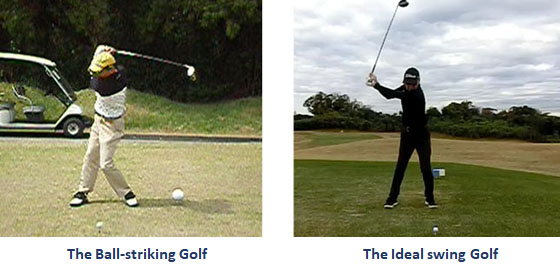

Director, Masayuki Yanagibashi
USGTF Teaching Pro
Another kind of Golf
Golf is a sport that involves striking a stationary ball. In the general concept, it revolves around striking the ball with a club. However, did you know that the act of “hitting the ball” in golf is what makes the game challenging? In many ball sports, the ball is in motion, prompting players to execute different movements to align with its trajectory. At times, these movements may even require the player to abruptly halt their body.
In golf, the ball is stationary. Therefore, the only way to move the ball is by moving your body. Swinging your body widely to hit the ball becomes the initial step in golf. Then, by aiming to strike it well, various body movements are executed to make the ball soar. Learning the body movements that contribute to improvement in golf takes a considerable amount of time.
So, what about the action of ‘swinging a club’? It is something that anyone can easily do while standing. It doesn’t require significant body movements. How much time would it take to learn the ideal way to swing a golf club? It wouldn’t take several years. With just a few minutes of daily practice, you can achieve a stable swing in as little as a month. The lowest point of the clubhead will also become consistent.
Let’s try placing the ball just slightly in front of the lowest point of the clubhead here. Please go ahead and try your ideal golf swing that you’ve learned. The ball will go flying. It might go low or veer to the right. Regardless, the ball will fly. You’re not “hitting the ball.” You’re just swinging. Yet, the ball flies. This is the essence of “another kind of golf,” where you don’t actually hit the ball.
First of all, let’s learn the ideal swing. You don’t need to focus on hitting the ball; just concentrate on the swing itself. The trajectory of the ball can be controlled by understanding ” the Ball Flight Laws.” Therefore, there is no need to worry.
- “the Ball Flight Laws” theory explains how the path of the clubhead and the direction of the clubface at impact determine the trajectory of the ball.
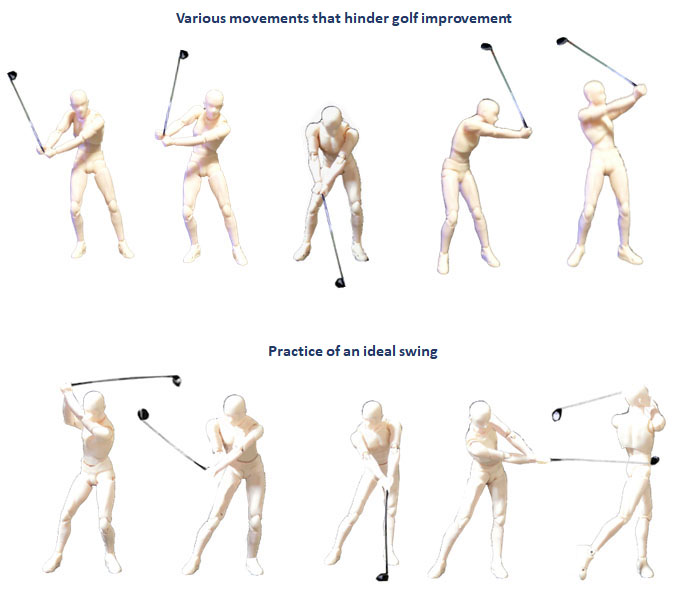
Is it difficult to start playing golf as an adult?
An adult who takes up golf later in life may struggle to replicate the same kind of swing as a professional golfer, even if they attempt to mimic it. Many successful professional golfers began playing golf during their junior years. It is commonly believed that learning golf at a young age facilitates the development of an ideal swing, possibly due to the physical abilities of children.
We compared the survey results of grip strength, softball throwing, side-to-side hopping, and standing broad jump from the ages of 6 to 20, as disclosed by Japanese government agencies.
Assuming the age of 6 is considered as 1, at approximately age 20, boys have about 4 times the grip strength, and girls have about 3 times the grip strength. In softball throwing, boys have about 3 times the strength, while girls have about 2.5 times the strength. Furthermore, in repetitive side-to-side hops and standing broad jumps, boys have twice the strength, while girls have approximately 1.5 times the strength.
From this table, it can be observed that adults have approximately twice as much physical strength in the lower body compared to junior golfers, while they exhibit a strength difference of over 3 times in arm strength.
The ideal golf swing requires minimizing the reliance on arm power. However, junior golfers, who typically have less arm strength, learn to effectively utilize their lower body to drive the ball. As they mature into adults, the swing developed during their junior years is retained and evolves into the ideal swing.
The ideal swing refers to a sequence of rotations in the lower body, upper body, and arms during the downswing, with the left arm (for right-handed players) positioned in front of the body at impact. Additionally, when viewed down the line, the clubhead’s path follows an on-plane swing, which is the midpoint between the line connecting the ball and the shoulders at address and the extension of the shaft.
Many amateur golfers have a “casting” swing that differs from the ideal swing, as evidenced by the results of physical fitness assessments. This is often attributed to their strong arm strength and a lack of power generated from the lower body. Even when they attempt to swing without relying on their arm strength, the inherent strength in their arms still affects their swing, resulting in deviations from the ideal golf swing. Therefore, it is crucial to shift the focus from merely “hitting the ball” to adopting the mindset of “swinging.” By doing so, amateur golfers can move closer to emulating the swing of a professional golfer.

The ideal golf swing is not comfortable
In everyday life, our bodies move without us having to think about it. You probably swing a golf club in the same way, relying on your natural movements. However, the ideal golf swing is quite different from the movements of everyday life, so you need to consciously adjust your actions.
Here, we will explain the most important hip movements.
In the movie ‘Saturday Night Fever,’ the main character has a signature pose in which he raises his right hand high. Please try to do this pose yourself. If your pose results in your right hip being elevated on your right leg (as shown in the image on the right), it is an extension of a normal movement you perform in your daily life. However, the hip movement in the main character’s pose is the complete opposite of your natural movement. If you attempt to imitate the same pose as the main character, you might find it quite uncomfortable.
Until now, the smooth movement of your hips has caused sway in your backswing.
To correct this sway, you will need to adjust your hip movement, which may feel slightly uncomfortable.
This means that the ideal swing starts with an uncomfortable motion.
However, with repeated practice, it will eventually become a natural movement.
Once you can replicate the hip movement of the main character in the movie, your posture will resemble that of a professional golfer.
Likewise, the Robot Swing Golf V1 Basic describes certain movements that are ideal for golf but differ from everyday life movements. It might be challenging to incorporate these movements into your swing right away, but through consistent practice, you will undoubtedly get closer to achieving the ideal swing.
*The details of this article are described in the “Robot Swing Golf V1 Basics,” which is currently available for sale on Amazon. -Read book

Let’s start the swing from the rotation of the hips and upper body
The golf swing is performed through rotational movement of the body. It is easier to rotate when there is a sense of power closer to the axis of rotation. A swing that emphasizes the rotation of the hips and upper body allows for high-speed rotation. If there is excessive power in the arms and hands, the rotational force becomes sluggish, and the axis of rotation becomes unstable. To imagine a stable and high-speed swing, both arms during the swing should always be positioned in front of the body, synchronized with the rotation of the hips and upper body.
The backswing begins with the rotation of the hips and upper body, while both arms rotate in sync, maintaining the address position. As the left arm becomes parallel to the ground, raising both arms high will bring you to the top position. The downswing becomes a faster swing when the rotation of the hips and upper body is synchronized with both arms.
*Please refer to the RSG Pro article “The moment of inertia of a golf swing.” -Read Now

Let’s try rotating the face along with the backswing
Amateur golfers often struggle with a lack of hip and upper body rotation during the backswing. Many professional golfers begin playing at a young age when their muscles are flexible, enabling them to rotate their hips and upper body sufficiently. Adults who take up golf later in life and attempt to rotate their hips and upper body while keeping their eyes on the ball may experience strain in the neck area. Consequently, they are unable to achieve adequate rotation to the rear.
One recommendation is to rotate your face along with your hips and upper body during the backswing. You may have seen this movement in the pre-shot routine performed by professional golfers before they take their shot. It involves simultaneously rotating the face with the club’s backward rotation until halfway back. By rotating your face along with your body, you enable your hips and upper body to fully rotate in the backswing while also being able to check the position of the club and the direction of the club face.
Please compare a backswing where you keep your eyes on the ball and a backswing where you turn your face along with the rotation of your hips and upper body. By turning your face together, you will be able to reach positions that were previously inaccessible without strain, allowing your hips and upper body to rotate smoothly. In this way, a backswing that allows for sufficient backward rotation of the hips and upper body enables a faster swing. Through repetitive practice, you will develop a consistent timing for returning your face to the front and become accustomed to the backswing that involves turning your face. With this approach, you will be able to achieve a full and effortless backward rotation of your hips and chest, which can lead to increased distance in your shots.
*The details of this article are described in the “Robot Swing Golf V1 Basics,” which is currently available for sale on Amazon. -Read book

On-plane swing
Many professional golfers have an on-plane swing, which refers to swinging the club along the ideal clubhead path derived from the swings of professional golfers and top amateur players.
When viewed down the line, two lines are established: one connecting the ball and the shoulders at the address position, and the other extending from the shaft. The line that lies between these two is referred to as the “on-plane,” and it is considered ideal for the clubhead to follow a nearly straight trajectory. If the arm swing is too forceful or if there is a “casting” motion in the swing, the clubhead will experience an early release, resulting in an early drop of the clubhead and preventing it from following a straight path.

Vertical Swing and Horizontal Swing
There are two types of golf swings: the vertical swing and the horizontal swing. The vertical swing involves raising and lowering the club in front of the body, while the horizontal swing implies swinging the club from side to side.
If you try to hit the ball, it won’t go very far unless you use a horizontal swing. However, since the golf swing involves rotating the body, even when swinging the club vertically, the club head moves diagonally. Furthermore, even in the case of a horizontal swing, during the backswing, the club head is lifted, causing it to move diagonally as well.
To swing on an on-plane trajectory, it appears to be effective to extend both arms and swing diagonally. However, maintaining a stable swing with this motion can be challenging. This is primarily due to the increased inertia moment caused by the weight of the arms.
On the contrary, a vertical swing entails a smaller inertia moment, enabling a faster swing speed. Moreover, the potential energy stored in both arms, raised to a high position, is converted into kinetic energy during the downswing, thus enhancing the impact force. Many female professional golfers have a vertical swing.
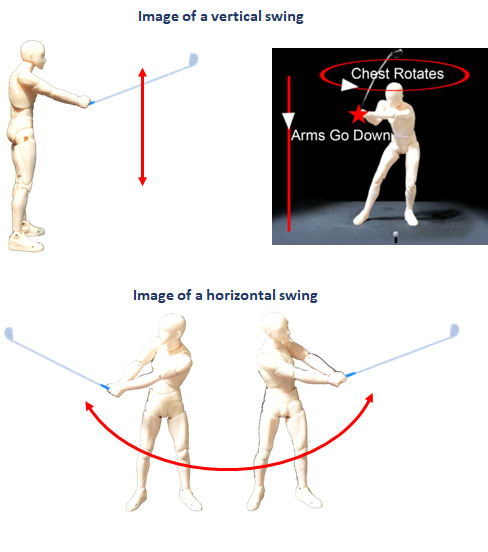
Rotation of the clubhead
Even if you align the clubface to be square at address, it is common for the clubface to open up at the top position. Therefore, during the downswing to impact, you need to rotate the clubface back to square. This is called rotation.
When the rotation of the clubhead is significant, it becomes challenging to stabilize the timing of returning the clubface from an open position to square. Therefore, mastering a swing with minimal rotation of the clubhead is a shortcut to achieving consistent shots. To do this, you will gradually orient the clubface towards the ground between the backswing and the top position. This movement is called a shut face. With a shut face, it is easier to square the clubface before impact.
During this time, the movements of both wrists should be conscious of the “flying wedge” (dorsiflexion) in the right hand and the “bow wrist” (palmar flexion) in the left hand. This positioning of both wrists allows for a hands-forward impact. Many professional golfers perform this movement.
*The details about “flying wedge” and “bow wrist” are described in the book “Robot Sung Golf V1 Basics” (available on Amazon). -Read book
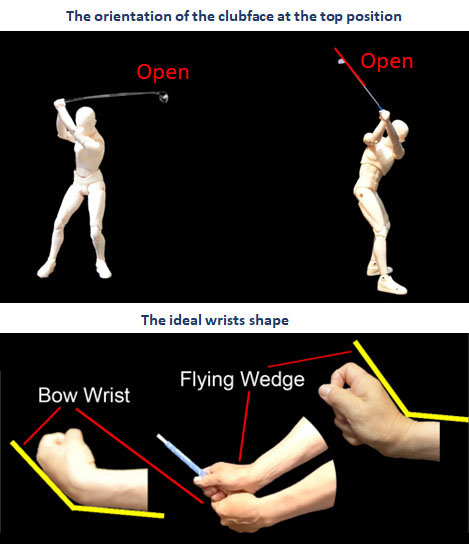
Leave the difficult things until you become advanced!
In a round of golf, players are allowed to carry 14 clubs. However, there is no problem with playing with fewer clubs. Professional golfers and advanced players select the optimal club from their entire set based on the situation and execute the intended swing to strike the ball. Naturally, they possess a thorough understanding of the trajectory and distance of the ball with each club.
Do you have clubs that you’re not good at, or do you find that the distances vary for each club from day to day? If so, one way to improve your score is to limit the clubs you use during a round.
Try restricting your club selection to the following: approach clubs (SW, AW, PW), 9-iron, 6-iron or hybrid club, and driver. Let’s allocate time for practicing with these clubs during your regular training.
You don’t need to worry too much about the accuracy of your driver shots during a round. From the second shot, focus on the management, avoiding bunkers, and getting the ball onto the fairway whenever possible. Don’t be too greedy with distance; if it’s a par-4 hole, choose a strategy that enables you to consistently reach the green with your third shot.
For example, let’s consider a flat hole with a distance of 360 yards. If the driver shot covers 200 yards, leaving approximately 160 yards to the hole, and there are multiple bunkers around the green, use a 9-iron for the lay up, and the short game shot should be aimed at landing the ball on the green.
When there is an open fairway in front of the green, you can try aiming for the green with a 6-iron or a hybrid club. If you hit a nice shot and get some roll, you should be able to reach the green in two shots. Even if you can’t, the ball will likely stop around the green. From there, avoid the approach shot and confidently go for a third shot to land the ball on the green with a putter.
By following this approach, you can avoid difficult shots in each round. Once you have consistently scored 99 or lower, evaluate the situation and gradually test your skills with different clubs.
Additionally, it can be effective to set your own target score, which we’ll refer to as ‘My Par.’ For example, you can set My Par at 90 for a standard 18-hole golf course with a par of 72. This means aiming for a bogey score on every hole. You would allow yourself one stroke more than each hole’s par, making it a manageable goal. Approach the game steadily without getting too greedy. You’ll find that scoring in the 90s is easier than you might think.
*The details of this article are described in the “Robot Swing Golf V1 Basics,” which is currently available for sale on Amazon. -Read book
*”Professional Approach Shot” (Reference Article) -Read Now
*”The stinger chip shot” (Reference Article) -Read Now
*”Learn the club’s features and overcome bunkers” (Reference Article) -Read Now
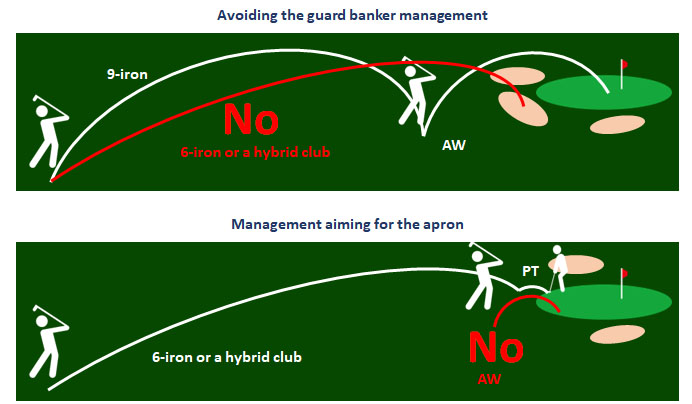
Robot Swing Laboratory’s putting app PUTTMAN
Click App PUTTMAN

Robot Swing Laboratory Books
1600-188x300.jpg)
Robot Swing Golf®
V1 Basics
Amazon Kindle
$9.99
-1-188x300.jpg)
Good-bye to Yips Forever!
Amazon Kindle
$5.00
